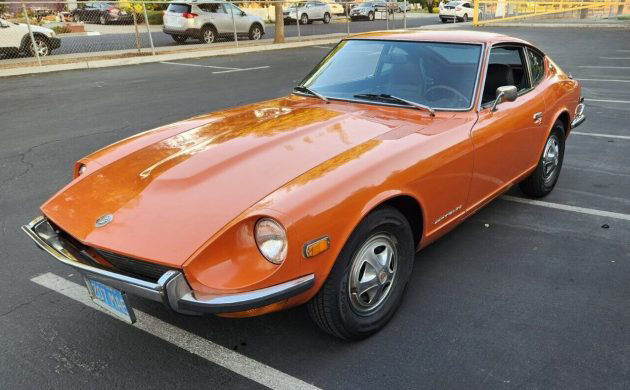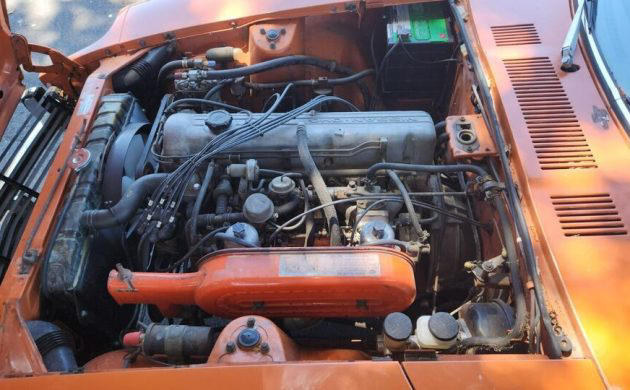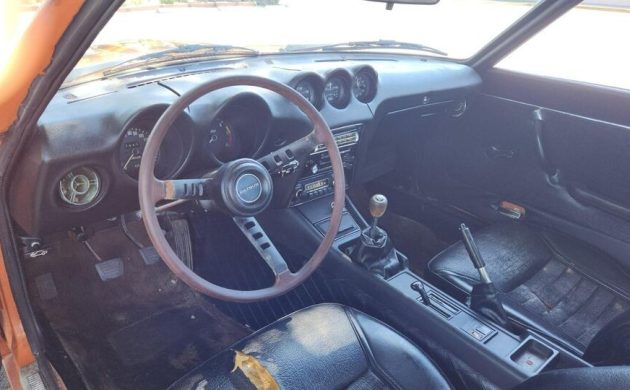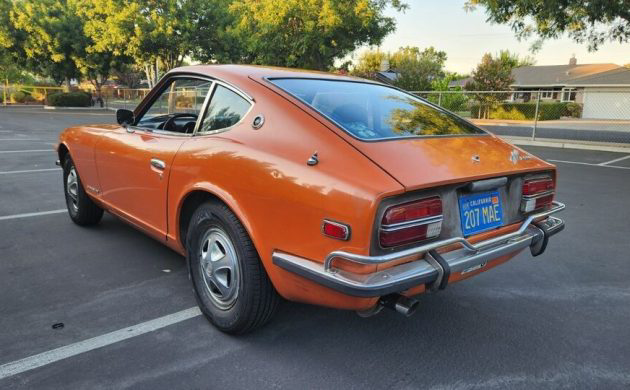The Datsun 240Z was one of the best things to happen to the sports car genre since the MGB. It hit the trifecta: it was pretty, powerful, and affordable. Introduced in 1969, Datsun’s new car had fully independent suspension, rack and pinion steering (an upgrade to the 510’s recirculating ball), front disc brakes, and a potent 2.4-liter OHC six-cylinder engine. The long-nosed hatchback styling reminded buyers of the sexy Jaguar XKE – a car that was out of range for many buyers by the late ’60s. Here on eBay is a two-owner, 1971 Datsun 240Z, with an asking price of $22,950 or offer. With just 73,000 miles on the clock, this Z is a running, driving example with a solid maintenance history. Motor it home from San Jose, California.
Datsun’s 2.4-liter overhead cam six-cylinder was developed directly from the 510’s L16 four-cylinder. Equipped with twin Hitachi carburetors, the engine makes about 151 hp – enough to propel the 240Z from zero to sixty in eight seconds. The four-speed manual from the 510 was strengthened to tolerate the new engine’s extra power. This car has new brakes, a new water pump and clutch fan, new tires, and tune-up parts, and it rides on new tires. Most of its hoses and belts have been replaced as well. The air conditioner compressor needs a rebuild and the heater vent cable is broken.
The interior betrays the better condition of the exterior, with nearly every surface calling out for attention. The seats need new upholstery, the carpets are faded, the dash is cracked to the point of nearly splitting apart. The seller reports that the glass is good, however. Nissan gave its export market “Z” interiors slightly different dimensions than its home market “Fairlady”: the steering wheel was set slightly closer to the dash and the seat rails were set farther back in American cars, to account for our rangier dimensions.
A few minor dents and less minor paint imperfections mar the exterior cosmetics. The tail panel is faded. No undercarriage photos are supplied but the seller notes there’s no “body rot”. Despite its sundry flaws, this 240Z sits firmly in the realm of collectible Z’s: the earliest cars (to early 1971) are top-shelf, while these Series 2’s, with their small bumpers, pre-emission engines, and still-fine details have seen strong interest. Driver-quality examples sell from $25k to $35k; you’ll pay closer to $45k for a very fine ’71. The list price is a bit aggressive given the work involved here, but there’s that “make offer” option – what do you think is a decent price?





Major game changer, right here. And about the only place you’ll find one, is where a snowflake/salt pebble never graced its wheel wells. Asians were on a roll. As if the Honda 750, also in ’69, didn’t cause enough of a ruckus, the 240Z finished it off. I don’t think it was intended for everyone, like a B210, also a game changer but it showed, Datsun meant business, going right for the Jaguars throat. The cheese? The price, natch. A new ’71 XKE or a 911T cost around $5200 bucks, a 240Z was $3526, and offered all the fun, PLUS, it didn’t leak oil. What’s amazing is they sold almost 16,000 in 1970, that number doubled in 1971, so no question, it was a hit. So where are they all? The ones that lived north of I-70 didn’t last long. Many never made it the 2nd owners, as a beater, they rusted so quickly. Still, a heck of a toboggan ride while they lasted. Without question, historically, the best Asian car to come across the ocean.
Nice find, Michelle. And though some folks will argue with you, Howard, you’re right on the money with your assessment of its being the best to come across the Pacific. Had a ‘72 the same color. Loved that car.
I too owned the ’72 model, same color. Drove it 150K in the salty Syracuse area. Had the fender flairs fixed twice.
Many adventures…once commandeered by a NY State Trooper whose car was blocked at an accident scene on I-81 to pursue a suspected fugitive. We caught up with him. The trooper cautioned me then to never drive that fast!
As a recent high school graduate I drove out to Colorado in a friend’s new Z in 1972, Datsun yellow it was. We drove straight from Jersey in I think 24 hours. Stayed with his cousin or something till we got a place. He left and I ended up pounding nails and occasionally sleeping on a switchback in a ’61 Buick airport limousine that had a platform where the seats used to be.
Whats odd about this one is the condition of the interior versus the exterior. Though I remember the drivers seat as being pretty thin and the dash was like a molded plastic or something, it seems pretty beat.
As I recall my friend had water ( snow)leakage issues in the back hatch,
I d love to have one now. Did’t someone refurbish the old Z’s and they were for sale by Nissan some years back?
Am not too sure about the “going for the Jaguar’s throat”. The Jaguar had real wood, leather, four-wheel stainless-steel disk brakes, a racing monocoque and twenty more miles per-hour top speed…not to mention even better looks…
This car was less money than a Jag and was way more likely to start. Might sound like I am being snarky, but I have had 3 Datsuns in my lifetime and 4 British cars (admittedly no Jags, though). The Brits make beautiful cars, but not dependable ones.
Tbone: that is a stereotypical reply and you admit to not having owned a Jaguar–which is an exotic as opposed to a mass-produced offering. The Jaguar twin overhead cam engine with polished hemispherical combustion chambers, according to Jay Leno–who knows a thing or two about cars and owns multiple Jaguars–is “bulletproof”. However, it has to be maintained per the owner’s manual and by someone competent, trained to work on these cars–something that disqualifies most traditional American V-8 mechanics. For example, take the tired old story about Jags “leaking oil” all over the place.
Someone not trained in Jaguar XK motors will think that putting fresh Prestone anti-freeze at regular intervals in the rad will take care of the cooling duties satisfactorily…but it will lead to oil leaks and other problems. The Prestone will cause electrolysis between the alloy head and the iron block, leading to clogging/erosion/overheating/damage to the now-overworked electric fans…and gasket/oil seal failure leading to oil leaks and all sorts of problems! It is then very easy to start attacking such an incompetently-maintained car as having lousy quality. Some British Leyland era Jaguars had bad quality because of endless union problems, but the Jaguars built under Sir William Lyons’ tenure and quality control standards were good cars…and to re-quote Jay Leno…”bulletproof” when serviced by someone with the right training. Would you trust a classic Ferrari’s maintenance to some kid at the local gas station who knows how to work on V-8s?… Also, Tbone, if English cars are so awful, why did Datsun put Hitachi carbs in the 240Z? They are English SU carbs built under licence.
While what you mention is true, experts since the get-go had dubbed this the “Japanese XKE”. Some say inspiration was from the Ferrari 250GT, but what was clear, was for half the money, it was pretty darn close and didn’t need a factory trained engineer to work on them.
Howard A: you absolutely don’t need to be “a factory-trained engineer” to work on an an E Type. I certainly am not…but I went to the trouble of getting both an owner’s manual and a factory workshop manual for my E Types and do all the work competently myself. The ’69 I currently own runs like a proverbial Swiss watch and my original electric fans (unrestored) still work well…and there isn’t a drop of oil on my garage floor–be it from the engine, the gearbox or the differential.
$64 question is, 45k of what? Dollar value changes with different merchandise, even if it is the same weight.
Snark aside, this looks very much like my late mother’s old Z-car: Same year and color scheme. But as I recall, hers was not A/C’d, so it can’t be hers.
Wow. What a blast from my past! My bought new ‘71) after waiting a few months for the dealer to get his consignment) was about the same color, but no A/C. It was a choice between that or a Triumph TR6. Bought for $3595, I sold it in ‘73, for exactly that, along with headers, slotted Ansen mags, crumby (noisy) duals, rust stains, and need for a new rear bumper. That wouldn’t have been the case with the “Trumpet”. That paved the way for a purchase of my ‘70 Vette, which I sold three years later for more than I paid for it. Ah youth! Then it’s marriage and a brand spanking new ‘75 Pacer. Gawd…how we can descend so fast! The Z-car looks great, and grew old in the right place. Mine on the other hand would have to have been crushed at age 5 having been delivered to me in northeast Ohio.
“How fast we descend.” Nothing like marriage and kids to put a kink in your giddy-up. I went from a 240z to a minivan in a blink of an eye.
Then add in a divorce and you don’t even have the minivan.
Having grown up when these were new, and having a good friend that owned one, I can say that these cars were a blast. They handled well, were sharp looking and weren’t slow. That said, I disagree that they competed with the Jaguar. These cars were affordable, and I’d say they stole more sales from the big 3 pony cars and MG/Triumph offerings than Jaguar.. Back in the day, Jags were a rich man’s car and a status symbol. These cars were more likely driven by a college kid or single 20 something.
This one looks nice and I think it’s worth 20k. I’d try to examine it in person before purchasing. Many of these were rusting on the dealers lot when new. Rust killed the majority of them. That said, the interior faults are a minor detail. Just about everything in the interior is available on the aftermarket. I wish I were closer to California. This looks like an easy project.